 |
 |
|
Tempering Chocolate
If you want to hand dip your own chocolate treats, whether they be candies or truffles or cookies or whatever else, you need to temper your chocolate. The reason is that all the different oils and cocoa solids in chocolate can form six different crystalline structures, one of which is much harder and more stable than the others, however to achieve this is a bit tricky.
In order to line up all the molecules to form the crystals we want, you must first melt the chocolate completely (say to 120 degrees) then cool it partially (to about 84-85 degrees) then warm it back up, but not by too much (to about 88-90 degrees). Miss these marks and you may have to repeat the process again, or worse yet you could end up with extremely soft and messy chocolate treats (of course they'll still taste wonderful, and it can be fun to lick the chocolate off your fingers, but that's up to you). Now, there is some debate about the exact temperatures and it's slightly different based on the type of chocolate you're using so these are just guidelines. |
|
 |
|
Ingredients
| Supplies |
| Medium Pot |
| Chopsticks, grate, rack or steamer insert |
| Instant/Digital Thermometer |
| Medium Bowl |
| Spatula |
| Chocolate |
|
|
| |
| Instructions
| |
|
click for a larger image |
Because you must work within such a narrow band of temperatures, heating the chocolate can be quite a challenge. Most people use double boilers, though professionals may use a controllable chafing dish of some sort. Alton Brown recommends using an adjustable heating pad/blanket. I just use a double boiler and have come up with a simple trick to help regulate the heat.
A double boiler is a pair of pans where the lower pan is filled with water that is heated by your stove. The upper pan holds the chocolate so it can melt over the warm water instead over direct heat which can burn it. |
|
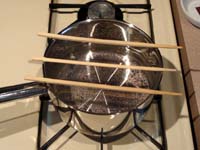 |
|
| If you don't have a double boiler (and who does anyway?) you can make one. Use a few chopsticks placed over a pot and put your bowl or another small pot on the chopsticks. Just be careful as the chopsticks aren't always very stable. I recommend square ones. Otherwise if you have a small grate or a cooling rack, you can use that instead. |
|
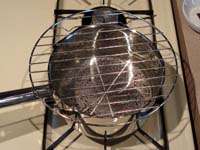 |
|
Of course, if you've got a steamer insert or a steamer pot, that might be the best.
Just one note of caution. Once you have melted your chocolate, getting any impurities, such as a drop of water, into the chocolate can cause it to sieze. Basically all the crystals are shocked into a new configuration and the entire mass of chocolate literally solidifies into a crumbly mess. If this happens, you will not be able to use the chocolate for dipping nor can you re-melt it. However, you don't have to waste it. Simply add more liquid (cream, coffee, water, liqueur) and create yourself a nice chocolate sauce for fondue or to pour over ice cream or other desserts. |
|
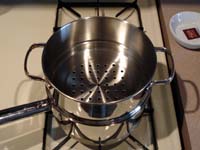 |
|
Once you've assembled your your double boiler, you can fill the bottom with water and turn on the stove. Put your small pot or bowl on top to begin heating. At this point, I like to put the thermometer into the water so I can see how hot it gets.
Now, it's important to understand how the water behaves. If you remember from chemistry, water has a very high specific heat, meaning it can hold a lot of energy. So, if we want to bring our chocolate up to 120 degrees, you don't need to boil your water (212 degrees) or it will be way too hot and will heat the chocolate too much. Once your water gets to 150 degrees, turn the heat down to the first or second lowest settings. |
|
 |
|
Add the chocolate to the upper pot/bowl. The smaller the pieces you can break it into the faster it will melt.
Unsweetened chocolate melts the best, but of course, it's not sweet. I personally like to use two parts of semi-sweet and one part unsweet. This helps thin out the chocolate a bit while keeping it very chocolatey and still sweet enough. Some people have even thought that it was dark chocolate!
Do not use chocolate chips, they do not melt well at all. Use a good baking chocolate. |
|
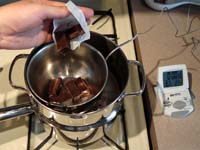 |
|
Now, even on low, your water may still get pretty hot. That's ok. Just stir it and scrape the sides periodically to keep the temperature uniform. When it is mostly melted but there are still chunks in it, you can turn off the heat and remove the chocolate from the double boiler. The rest of the chocolate should melt soon as well.
Once the chocolate is completely melted, allow it to cool. Clean and dry your thermometer and then put it in the chocolate. If you want to speed it along, get another larger bowl and fill it with a small amount of cool water and put the chocolate bowl into it. Change the water if it gets warm. |
|
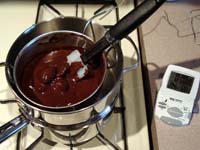 |
|
Meanwhile, get a cup of cool water and pour it into the lower half of the double boiler. What you want to do is lower the temperature so that when you use it to warm up the chocolate again, it won't overheat.
If you can touch the pot but it starts to get too hot after a few seconds, that's about 120 degrees. If you can touch the pot and it's hot but you can keep your hand there, that's about 110 degrees and that's your target.
Once your chocolate reaches 84 degrees, put it over the double boiler again. Stir it and scrape the sides to distribute the heat until it reaces 88-90 degrees. If it's taking too long and the double boiler is not hot, you can turn the stove to low for a little bit. If your chocolate goes above 90 degrees, add more cool water to the double boiler. You should be able to get to a point where your chocolate hovers between 88-90 for a good amount of time.
Now start dipping away! I like to use chopsticks to dip things since they're small and versatile. |
|
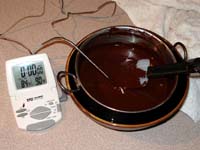 |
|
|
|
 |
 |

